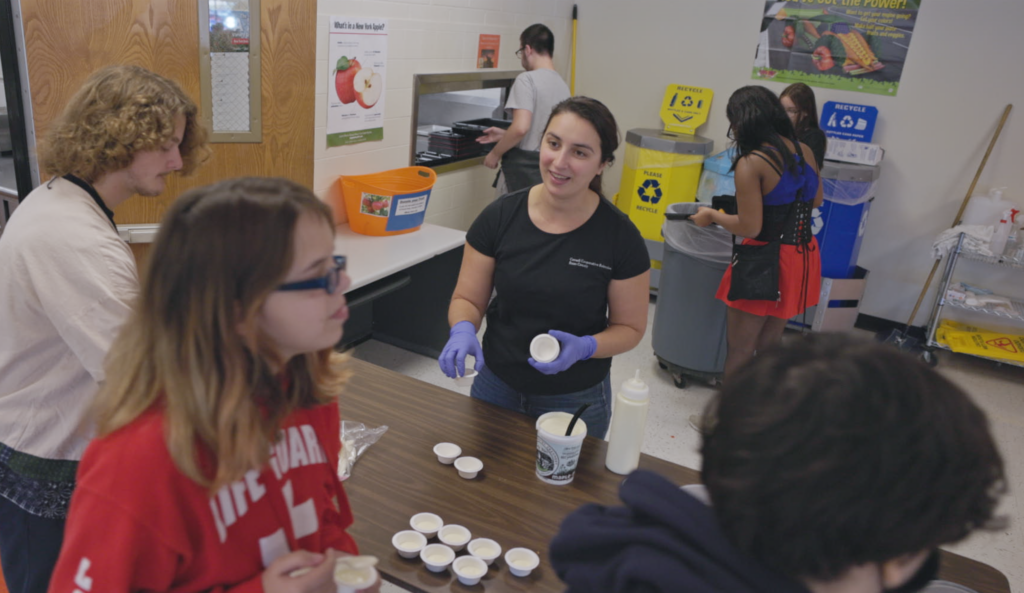By Tim Rowland
Supporters of Farm to School had battled the conventional wisdom that food in its natural state was too costly and too hard to prepare. They’d won that fight, but now a larger one loomed: getting students to eat it.
Too many came from homes where parents, working multiple jobs or otherwise spread too thin, were falling back on processed meals that bore little resemblance to food in its natural state — a paradigm reinforced by school cafeterias. Growing children, therefore, became accustomed to flavors that came from a box, not from a garden.
“It can be hard getting kids to eat fruits and vegetables,” said K’Cee Leavine, assistant to the food service director for Champlain Valley Educational Services. “Many of them had never seen a pineapple, never seen a plum.”

Processed sweets and cereals had become institutionalized, and young palates had become accustomed if not addicted to them. So had the entire educational food chain. When cafeterias introduced fresh eggs to the breakfast menu, on-site state inspectors were befuddled. Their check-off sheets had no box for proteins at breakfast.
So, food-service managers began the task of re-educating young palates to more complex flavors and appreciating food cooked from scratch.
At first it took a little trickery. “We’d play ‘hide the squash’ and add black beans to the brownies,” Leavine said. Kids quickly warmed to the game. Eating opportunities became learning opportunities.
Meghan Dohman, Farm to Institution Educator for Cornell Cooperative Extension of Essex County, said that when children would take a field trip to a farm and see, for instance, a beet pulled from the ground, they were curious to see what the vegetable tasted like.
They are fascinated, Dohman said, to learn that the taste of yogurt can change through the seasons, based on the type of grass or hay the dairy animals are eating.
Regardless, kids still often preferred pastries and sweet breads for breakfast. Even teachers occasionally complained when chocolate milk was removed from the menu. Instead, Julie Holbrook, Shared Food Service Director for CVES, instructed cafeteria cooks to place loaves of dough in the ovens — and then close the vent. As the smell of fresh-baked bread wafted through the hallways, students became eager for lunch.
“Fresh food is better tasting, better smelling, and it costs less,” Holbrook said.
And the notion that kids wouldn’t eat what was good for them was perpetuated more by the adults than the children themselves. “We had to fight that battle with adults who said, ‘kids are going to hate this,’” Leavine said. It turned out that the kids were more willing to experiment than the adults had given them credit for.
And most importantly, improved nutrition led to healthier kids who were more prepared to learn. When Holbrook looked at Attention Deficit Hyperactivity Disorder, what she saw wasn’t the result of a bad brain, it was the result of bad food. Hyperactivity presented itself as a classic sugar rush, and failure to focus was a classic sugar crash.
“(With proper nutrition), teachers were amazed at how much calmer the kids were,” Holbrook said. “They would go to class and actually pay attention.”
But quality comes at a cost, and mass-produced, processed foods had a reputation for being cheap and easy. Certainly cheaper and easier than foods raised locally with consciousness and care. Holbrook had a sense the conventional wisdom wasn’t true, but she had to prove it.
Farm to School is a beneficial program for students and producers, but if it costs too much, food service managers knew their best intentions were unlikely to see the light of day.
This is part four in a series of five articles; you can read the other stories in this series here.
